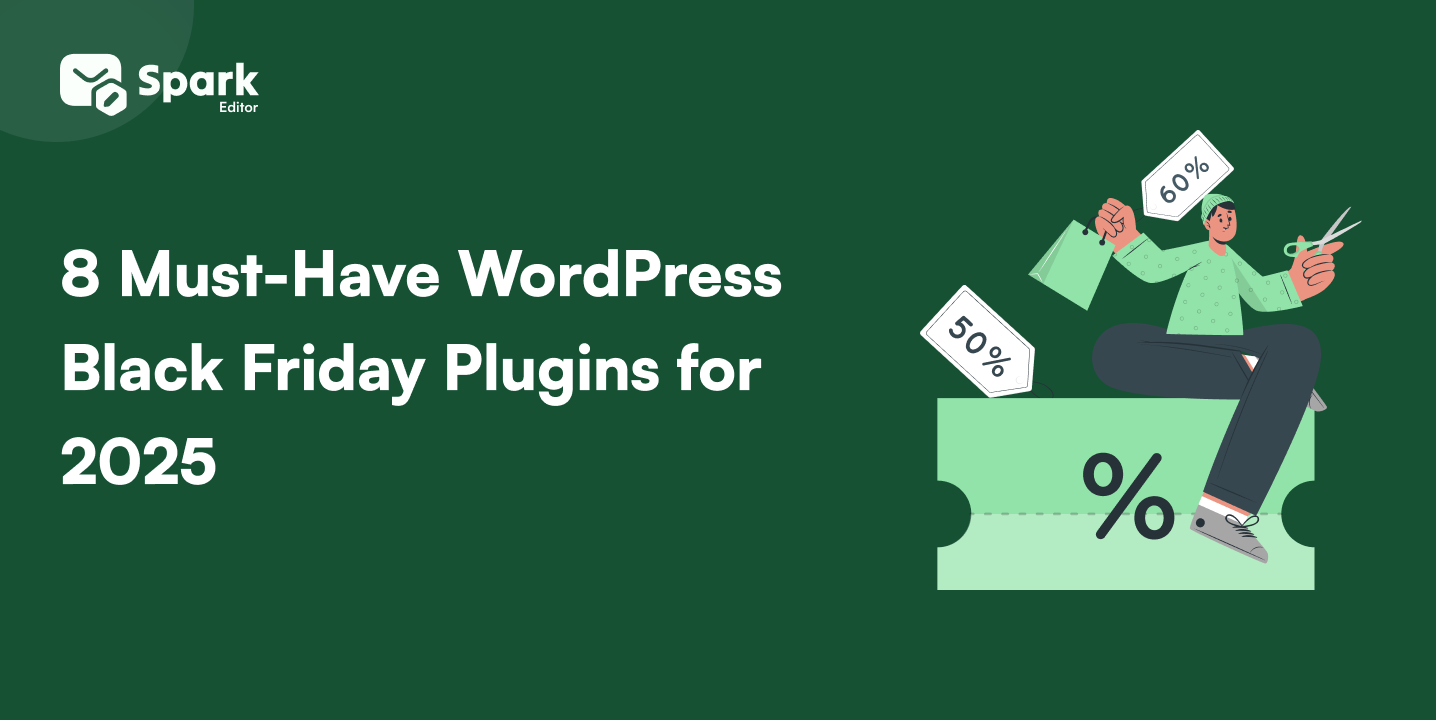Are your WooCommerce emails optimized for mobile? In today’s world, responsive WooCommerce email templates are essential for reaching customers on any device. By embracing mobile-first email design, you ensure a seamless experience that adapts to smaller screens before scaling to larger ones.
Custom WooCommerce email templates give your brand a unique, professional look, while WooCommerce email customization allows you to fine-tune every detail. Email marketing for WooCommerce thrives when your emails are both visually appealing and functional.
Implementing email template best practices and using a drag-and-drop email builder make it easy to design stunning emails. WooCommerce mobile optimization ensures your messages reach your audience, no matter where they are.
Ready to improve your email performance? Let’s dive into the key practices!
Design your emails with Spark Email Editor using drag-and-drop for faster email creation.
Practices for Effective Responsive WooCommerce Email Templates
When creating responsive WooCommerce email templates, it’s essential to follow the best practices that not only improve the design but also enhance user engagement. Responsive design ensures your emails look great and work perfectly across all devices, especially with the growing use of smartphones for email opens.
Mobile-First Design Strategy
A mobile-first email design approach is one of the core principles in building responsive WooCommerce email templates. With a majority of consumers accessing their emails via mobile devices, prioritizing mobile optimization is crucial.
Start by designing your emails for smaller screens, focusing on readability, quick load times, and touch-friendly elements. After perfecting the mobile version, scale up the design to fit larger screens. This ensures your emails look great and are easy to navigate, regardless of the device.
Simplify Your Content
Cluttered emails can overwhelm the reader and reduce engagement. Instead, follow email template best practices by simplifying your content. Prioritize important messages and calls to action (CTAs), using clear and concise text.
A single-column layout works best on mobile devices, allowing users to focus on one message at a time. Be sure to break your content into digestible sections, with headings, short paragraphs, and bullet points, making it easy to read on smaller screens.
Optimize Images for Speed and Responsiveness
Images play a crucial role in WooCommerce emails, but they must be optimized for fast loading, especially on mobile. WooCommerce email customization involves using images that retain quality but have smaller file sizes to ensure quick loading times.
Too many large images can slow down your email, leading to a poor user experience. Moreover, make sure the images are flexible, resizing correctly on all screen sizes, ensuring that they don’t break the layout or appear pixelated.
Prioritize Clear and Actionable CTAs
Call-to-action buttons should be easy to find and click. When designing responsive WooCommerce email templates, ensure your CTAs are large enough for mobile users to tap without difficulty. Touch-friendly buttons, ensuring they stand out visually, using contrasting colors and bold text.
Place the most important CTAs above the fold to catch the reader’s attention immediately. Make sure the text on the CTA buttons is action-oriented, using words like “Shop Now” or “Get Started” to prompt action.
Ensure Cross-Device Compatibility
Achieving cross-device compatibility is crucial to ensuring that your WooCommerce email design works seamlessly on various platforms, including desktops, tablets, and mobile devices. You should test your emails across multiple devices and email clients to ensure they render properly.
WooCommerce email testing tools can help you check for broken layouts, distorted images, or unreadable text, so you can fine-tune your email design before hitting send.
Maintain Visual Consistency and Branding
Your emails should reflect your brand’s identity, even in your email design. Make sure you maintain visual consistency by using your brand’s colors, fonts, and logo in the responsive WooCommerce email templates.
Consistent branding helps build trust with your subscribers and increases brand recognition. Don’t overcomplicate the design; keeping it simple and in line with your website’s aesthetic reinforces the professionalism and reliability of your WooCommerce store.
Leverage Drag-and-Drop Email Builders
For users who don’t have extensive coding skills, drag-and-drop email builders are invaluable tools for creating responsive WooCommerce email templates. These tools allow for easy customization and give you the flexibility to design professional emails without writing a single line of code.
Platforms like Spark Editor and other WooCommerce-integrated drag-and-drop builders enable users to modify layouts, add elements, and personalize content easily, saving time and effort.
Test, Test, and Test Again
Finally, no matter how well-designed your email is, testing is key to its success. WooCommerce email testing allows you to preview your emails on various devices and email clients to ensure that everything appears as intended.
Testing helps identify potential issues, like misaligned images, broken links, or poorly formatted text, before the email reaches your subscribers. Run tests regularly and use feedback from analytics to refine future email designs.
Case Study: Casper’s Success with Responsive WooCommerce Email Templates
Casper, a leading online mattress retailer, faced a challenge that many eCommerce businesses encounter: the majority of their customers engaged with emails on mobile devices. However, their email campaigns were not optimized for mobile, leading to poor user experiences and reduced conversions.
To resolve this, Casper revamped their email marketing for WooCommerce strategy by adopting a mobile-first email design. By focusing on responsive WooCommerce email templates, they ensured their emails were visually appealing and functional across all devices.
Key elements of their approach included:
- Custom WooCommerce email templates featuring single-column layouts for smoother mobile navigation.
- Mobile optimization with large, touch-friendly buttons for easy interaction.
- Optimized images that loaded quickly without losing quality.
- Consistent branding to reinforce their identity across desktops and mobile devices.
The results were impressive:
- 25% increase in click-through rates (CTR), particularly on mobile.
- A 15% boost in conversion rates, attributed to the improved mobile experience.
- A 20% drop in email bounce rates, showing better engagement and deliverability.
Their revamped emails not only enhanced user engagement but also led to stronger brand presence and increased loyalty.
By using tools like a drag-and-drop email builder and consistently testing their emails with WooCommerce email testing, Casper ensured their emails were optimized for all platforms, leading to higher conversions and customer satisfaction.
Start customizing your emails with Spark Email Editor templates for higher conversion rates!
Final Thoughts
Creating responsive WooCommerce email templates is no longer a luxury—it’s a necessity. By adopting mobile-first email design and following email template best practices, you can significantly boost engagement and drive more conversions.
Don’t forget to leverage tools like drag-and-drop email builders and conduct regular WooCommerce email testing to ensure every email is perfectly optimized for all devices.
Ready to take your WooCommerce email marketing to the next level? Start implementing these best practices today and watch your customer engagement soar!
Frequently Asked Questions
How do I create a responsive email template in WooCommerce? You can create a responsive email template in WooCommerce by using a mobile-first design approach, drag-and-drop builders, or customizing pre-made templates to suit your brand’s needs.
Why is responsive design important for WooCommerce emails? Responsive design is crucial because it ensures that your emails look and function well on any device, particularly on mobile, where a large percentage of users open their emails.
What are the best practices for designing WooCommerce email templates? Best practices include using a mobile-first design, maintaining visual consistency, optimizing content hierarchy, and testing across devices and email clients.
How do I ensure my WooCommerce emails are mobile-friendly? To ensure your WooCommerce emails are mobile-friendly, use a single-column layout, large touch-friendly buttons, and optimized images that load quickly on mobile devices.
How can I improve the deliverability of my WooCommerce emails? Improving deliverability involves using clean, responsive design, avoiding spammy content, regularly cleaning your email list, and testing your emails across various platforms to ensure they render correctly and reach the inbox.





